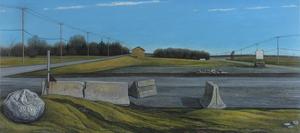Gerald Harris paints the 'Lost Highway' of Route 41
05/18/2013 01:10AM ● By Brian O
Harris Photo by Richard L. Gaw
An artist's experiences on the road
By Richard L. Gaw
Staff Writer
For 15 years, Gerald Harris of Toughkenamon was the go-to guy at Mr. Mulch, a main supplier of soil, mulch, gravel and stones to businesses and homeowners throughout southern Chester County. From the company's miniscule office on Gap-Newport Pike in Landenberg, Harris facilitated hundreds of deliveries every week.
Then the Pennsylvania Real Estate Investment Trust came calling.
They wanted to purchase the property where Mr. Mulch stood as part of a colossal project that became known as White Clay Point, and their plan called for the Mr. Mulch property to become a Wawa store. The owners sold, and Harris was suddenly out of a job.
The wellspring of emotions from which art emerges is a crowded one. Grief and joy usually top the list. What brought Harris -- who has been painting since he was 5 -- to the former site of his former employer may have been funneled through his schooling at the Pennsylvania Academy of the Fine Arts, but the emotion he was feeling was pure anger. Positioned on location, he sketched the landscape, scarred with the barren rubble of where he once worked. Telephone lines. Crumbling cement. Thatchy, yellow grass. He heard old Hank Williams songs in his head as he worked. Pavement. He began the initial sketches for "Ball and Chain" in 2009 and finished it in 2012.

His egg tempera "Ball and Chain" is part of a 21-piece contribution he's making to "Lost Highway 41: Revisited Blues," now at the Street Road Gallery in Cochranville. In addition to Harris' work, artists Egidija Ciricaite, Thomas Sowden and Danny Aldred are represented. His current work was also displayed at the Stroud Water Research Center in Toughkenamon.
"For 15 years, I called this place home, and now, I was there as an artist," Harris said. "There's something about being able to get out one's frustrations, about being let go after the 15 years I'd put into the business. Happy art can be a little bit too sweet. It may have its spot in places, but I want to be more contemplative artist. A happy feeling goes away too quickly. The release of anger and frustration lasts longer in art. Everything in that painting tied itself together with what was going on inside me during that time."
Harris's second painting in the exhibition is called "The Misanthrope," named for a painting by the 16th-century artist Pieter Bruegel. In the painting, a heavy-set and black-bearded young man wearing a black Hank Williams T-shirt walks on the side of Route 41. Behind him are the stark images of a barren highway -- a crumbling gas station, trash and an ominous sky. Harris said the inspiration for the painting came from meeting a young man named Derek, who said he was in a band called Misanthropy.
"The misanthropic idea appealed to me, because everyone, at one time or another, feels as if the world is against them," he said. "Here you are doing your best, and there's push back everywhere, and you throw your hands up and say that you're sick of it."
With their Hopper-like starkness, both "Ball and Chain" and "The Misanthrope" depict Route 41 as a lost highway, in keeping with the theme of the Street Road exhibit. But Harris applies the term "lost" not to the highway, but to what it may become.
"White Clay Point would truly be the definition of 'lost,'" Harris said. "It would look like the Exton Town Square or any other mall that advertisied itself as a town center, which really is nothing more than a bunch of stores linked together with some benches."
Harris, who is now the co-owner of a landscape, construction and masonry company, does not define his talents as an artist through the prism of the area where he has lived all his life. In an area full of artists who are content to depict the beauty of the landscape in their paintings, Harris looks at his work as a running commentary, much like the narrative in a novel, divided according to chapters.
"My paintings are paintings of strength, of weakness, of a universal idea," he said. "If you paint a pretty picture of Chester County, it might be a big hit at a local art asociation, but what's that going to say to someone who is not from the area? If there is something deeper to grab onto, then it becomes art.
"As an artist, you have a responsibility to make your art with integrity and honesty,” he said. “I feel I'm putting things down that are real things and not projected ones, and not what I think people would want to see. I want to be able to give people that same sense of the honesty, even though our interpretation of the art may be different.”
To see more, visit www.gwh2.com.
To contact Staff Writer Richard L. Gaw, e-mail [email protected].


